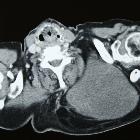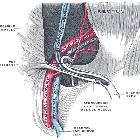paratestikuläre Tumoren

Rhabdomyosarcoma
• Paratesticular rhabdomyosarcoma - Ganzer Fall bei Radiopaedia

Spermatic
cord leiomyosarcoma • Spermatic cord liposarcoma - Ganzer Fall bei Radiopaedia
A paratesticular mass may derive from a number of structures that surround the testicle within the scrotum; most commonly, they derive from the spermatic cord.
Pathology
The masses can be categorized as benign (70%) or malignant (30%).
Etiology
Benign
- spermatic cord lipoma (most common paratesticular mass)
- adenomatoid tumor (most common epididymal mass)
- epididymal leiomyoma
- epidermoid inclusion cyst
- epididymal papillary cystadenoma (associated with von Hippel Lindau disease)
- rare entities
- leiomyoma
- spermatic cord fibroma
- scrotal hemangioma (very rare)
- mimics of tumors include polyorchidism and splenogonadal fusion
- scrotal hemangioma
Malignant
- spermatic cord sarcomas
- adults
- rhabdomyosarcoma (most common; ~40% of paratesticular tumors )
- malignant fibrous histiocytoma (rare)
- spermatic cord leiomyosarcoma (rare)
- spermatic cord liposarcoma (rare)
- malignant schwannoma
- myxochondrosarcoma
- children
- adults
- metastases: <10% of epididymal masses are metastases
See also
Siehe auch:

 Assoziationen und Differentialdiagnosen zu paratestikuläre Tumoren:
Assoziationen und Differentialdiagnosen zu paratestikuläre Tumoren:






